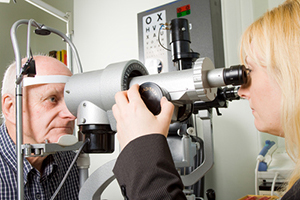 Merry Christmas from everyone at Blue Heron Health News!
Merry Christmas from everyone at Blue Heron Health News!
Today, we’ve a little different angle to your natural health discovery.
You see, a recent survey of 120,000 patients by the insurance company VSP Vision Care concluded that an eye exam first revealed 34 percent of diabetes cases, 39 percent of high blood pressure cases, and 62 percent of high cholesterol cases.
An eye examination by a qualified and informed eye specialist can reveal as much (and sometimes more) about your health as your general health checkup.
For 10 more reasons not to skip that regular eye exam, check out these 10 health conditions that your eye specialist can detect very early on:
1. Schizophrenia and bipolar disorder. People with these mental illnesses track patterns differently from people in the general population. Schizophrenics, for example, struggled to track slow moving objects.
2. Brain tumors. Poor coordination between your two eyes can indicate a brain tumor. For example, if one eye remains fixed while the other moves, or if one eye dilates when the other contracts, you might be in trouble as it shows that the optic nerve that connects your eyes to your brain is not working normally.
3. Multiple sclerosis. This abnormal hardening of body tissue and nerve tissue in the brain and spinal cord should ideally be detected early, as it is progressive. Eye ticks, the blurring of vision in and out of the full visual field, and a banana-shaped visual field defect below your macula caused by damage to your optic nerve are the best indications.
4. Liver disease. If your eye doctor says that the whites of your eyes are yellow, it might indicate hepatitis, obstruction of the bile duct, or some more serious liver disease.
5. Stroke. If you have already had a small stroke, you are obviously in danger of having more. An eye exam can reveal disturbances in your field of vision. Stroke sufferers often struggle to coordinate their eyes or see objects in their full visual field because of damage to their brains.
6. A brain aneurysm. When the blood vessels in your brain swell, they are in danger of bursting, killing you almost instantly. Drooping eyelids, increased eye pressure, crossing eyes, and retinal bleeding are all signs that your life might end soon.
7. Vitamin A deficiency. Some of the first signs of vitamin A deficiency are loss of night vision and damage to the surface of your eyes. Your grandmother was right, eat your carrots!
8. High cholesterol. If you have white rings around your eyes or yellow bumps on your eyelids, you’d better get your cholesterol tested. These are signs of plaque in your arteries.
To lower your cholesterol naturally – without drugs – and to clear out your clogged arteries, click here…
9. Diabetes. If your blood sugar is high, small blood vessels in your retina burst, which eye specialists pick up as small red spots on your retina. Since it indicates high blood sugar rather than diabetes itself, it can even be used for early diagnosis while the condition is still easily treatable.
10. High Blood Pressure. If your blood pressure is too high, the blood vessels at the back of your eyes struggle as much as those in the rest of your body. An eye specialist can detect burst arteries, tiny hemorrhages, and hardened and narrowed arteries, all signs that the blood vessels in the rest of your body might be damaged and undermine comfortable blood flow too.
Discover how 3 easy exercises drop your blood pressure below 120/80 – starting today…
Bonus number 11: studies show that your optometrist or ophthalmologist can even detect early melanoma cancers from your eye exam…before your dermatologist even has any indication. Certain, specific changes in the retina can be seen during a slit-lamp exam that will tell your eye doctor if you need to follow up, many times while it is still early enough to treat.

 Overcoming IBD
Overcoming IBD Multiple Sclerosis
Multiple Sclerosis Banishing Bronchitis
Banishing Bronchitis Gum Disease Gone
Gum Disease Gone Overcoming Onychomycosis
Overcoming Onychomycosis Neuropathy No More
Neuropathy No More The Prostate Protocol
The Prostate Protocol Brain Booster
Brain Booster
 Ironbound
Ironbound
 Solution for Shingles
Solution for Shingles
 The Bone Density Solution
The Bone Density Solution
 The Ultimate Healing Protocol
The Ultimate Healing Protocol
 The Parkinson's Protocol
The Parkinson's Protocol
 The Chronic Kidney Disease Solution
The Chronic Kidney Disease Solution
 Overthrowing Anxiety
Overthrowing Anxiety The Fatty Liver Solution
The Fatty Liver Solution The Hypothyroidism Solution
The Hypothyroidism Solution
 The End of Gout
The End of Gout The Blood Pressure Program
The Blood Pressure Program
 The Oxigized Cholesterol Strategy
The Oxigized Cholesterol Strategy
 Stop Snoring And Sleep Apnea Program
Stop Snoring And Sleep Apnea Program
 The Arthritis Strategy
The Arthritis Strategy The Vertigo & Dizziness Program
The Vertigo & Dizziness Program The 3-Step Diabetes Strategy
The 3-Step Diabetes Strategy Hemorrhoids Healing Protocol
Hemorrhoids Healing Protocol The Erectile Dysfunction Master
The Erectile Dysfunction Master Weight Loss Breeze
Weight Loss Breeze The IBS Program
The IBS Program The Insomnia Program
The Insomnia Program The Migraine and Headache Program
The Migraine and Headache Program The Neck Pain Solution
The Neck Pain Solution The Menopause Solution
The Menopause Solution The Ejaculation Master
The Ejaculation Master The TMJ Solution
The TMJ Solution The Acid Reflux Solution
The Acid Reflux Solution The Fibromyalgia Solution
The Fibromyalgia Solution The Psoriasis Strategy
The Psoriasis Strategy